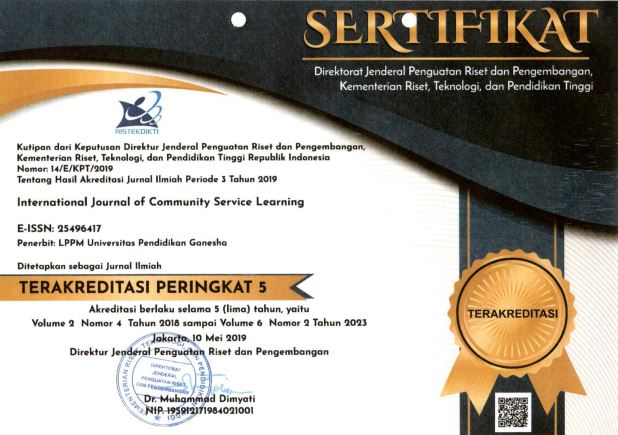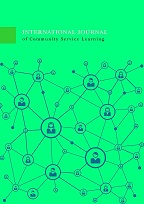Pendampingan Penulisan Karya Ilmiah Remaja untuk Meningkatkan Kreativitas dan Literasi
DOI:
https://doi.org/10.23887/ijcsl.v3i3.20867Abstract
Pengabdian ini bertujuan untuk melakukan pendampingan untuk penulisan karya ilmiah remaja pada siswa MA Muhammadiyah 1 Malang. Subjek pengabdian berjumlah 10 orang yang terdiri dari 4 orang guru dan 6 orang siswa. Kegiatan pengabdian dilaksanakan selama 4 bulan. Instrumen untuk mengambil data terdiri dari soal pilihan ganda, soal essay beserta rubrik penilaian, dan kamera untuk dokumentasi. Hasil pengabdian menunjukkan bahwa pemahaman subyek pengabdian terkait metode ilmiah secara umum cukup tinggi (di atas 50%). Sedangkan kemampuan berpikir kreatif masih cukup rendah yakni 33% pada dua indikator (“dapat diterapkan” dan “keterjangkauan biaya”) meskipun indikator “kemanfaatan” cukup tinggi (83%). Pada aspek kemampuan literasi, mayoritas (83%) subyek pengabdian juga menunjukkan kemampuan pada level paling redah yakni nominal, sedangkan 17% lainnya pada level fungsional. Berdasarkan hasil pengabdian, maka disarankan untuk memberikan pendampingan dengan frekwensi yang lebih intensif kepada siswa MA Muhammadiyah 1 Malang dengan memberikan fokus yang lebih tegas pada berbagai aspek kemampuan yang masih rendah.
Kata Kunci: Kreativitas, literasi penulisan karya ilmiah,.
References
Adzliana Mohd Daud, Jizah Omar, Punia Turiman, & Kamisah Osman. (2012). Creativity in science education. Procedia - Social and Behavioral Sciences, 59, 467 – 474. https://doi.org/10.1016/j.sbspro.2012.09.302
Agolla, J. E. (2018). Human capital in the smart manufacturing and industry 4.0 revolution. In A. Petrillo, R. Cioffi, & F. De Felice (Eds.), Digital Transformation in Smart Manufacturing (pp. 41–58). https://doi.org/10.5772/intechopen.73575
Arends, R. I. (2012). Learning to teach (9th ed.). Retrieved from http://onlinelibrary.wiley.com/doi/10.1002/cbdv.200490137/abstract
Aulbur, W., CJ, A., & Bigghe, R. (2016). Skill development for Industry 4.0. India: Roland Berger. Retrieved from http://www.globalskillsummit.com/whitepaper-summary.pdf
Birzina, R. (2011). Biology students’ comprehension of learning as a development of their biologycal literacy. In Scientific Papers University of Latvia, Vol. 778. Retrieved from https://www.researchgate.net/publication/269101031_Biology_students’_comprehension_of_learning_as_a_development_of_their_biological_literacy
Changwong, K., Sukkamart, A., & Sisan, B. (2018). Critical thinking skill development: Analysis of a new learning management model for Thai high schools. Journal of International Studies, 11(2), 37–48. https://doi.org/10.14254/2071
Cook, P., & Walsh, M. (2012). Collaboration and problem-based learning: Integrating information literacy into a political science. Communications in Information Literacy, 6(1), 59–72. Retrieved from http://www.comminfolit.org/index.php?journal=cil&page=article&op=view&path%5B%5D=v6i1p59
DeBoer, G. E. (2000). Scientific literacy: Another look at its historical and contemporary meanings and its relationship to science education reform. Journal of Research in Science Teaching, 37(6), 582–601. https://doi.org/10.1002/1098-2736(200008)37:6<582::AID-TEA5>3.0.CO;2-L
Dole, S. F., Bloom, L. A., & Doss, K. K. (n.d.). Rocket to creativity: A field experience in problem-based and project-based learning. Retrieved from https://files.eric.ed.gov/fulltext/EJ1120599.pdf
Erkol, S., & Ugulu, I. (2014). Examining Biology Teachers Candidates ’ Scientific Process Skill Levels and Comparing These Levels in Terms of Various Variables. In 5th World Conference on Educational Sciences - WCES 2013 Examining (Vol. 116, pp. 4742–4747). Elsevier B.V. https://doi.org/10.1016/j.sbspro.2014.01.1019
Ghazivakili, Z., Norouzi Nia, R., Panahi, F., Karimi, M., Gholsorkhi, H., & Ahmadi, Z. (2014). The role of critical thinking skills and learning styles of university students in their academic performance. Journal of Advances in Medical Education & Professionalism, 2(3), 95–102. Retrieved from https://www.ncbi.nlm.nih.gov/pmc/articles/PMC4235550/
Gunawan, A Harjono, H Sahidu, & Nisrina. (2018). Improving students’ creativity using cooperative learning with virtual media on static fluida concept. In International Conference on Science Education (ICoSEd) . IOP Publishing. https://doi.org/10.1088/1742-6596/1006/1/012016
Hartmann, E. A., & Bovenschulte, M. (2013). Skills needs analysis for “Industry 4.0” based on roadmaps for smart systems. In SKOLKOVO (Ed.), Using Technology Foresights for Identifying Future Skills Needs. Global Workshop Proceedings (pp. 24–36). Moscow. Retrieved from https://www.iit-berlin.de/de/publikationen/skills-needs-analysis-for-industry-4-0201d-based-on-roadmaps-for-smart-systems/at_download/download
Lemke, M., Sen, A., Pahlke, E., Partelow, L., Miller, D., Williams, T., … Jocelyn, L. (2004). International Outcomes of Learning in Mathematics Literacy and Problem Solving: PISA 2003 Results From the U.S. Perspective. Highlights. NCES 2005-003. US Department of Education. Retrieved from http://eric.ed.gov/?id=ED484183
Lin, C.-S., & Wu, R. Y.-W. (2016). Effects of web-based creative thinking teaching on students’ creativity and Learning Outcome. EURASIA Journal of Mathematics, Science & Technology Education, 12(6), 1675–1684. https://doi.org/10.12973/eurasia.2016.1558a
Osman, K., Hamid, S. H. A., & Hassan, A. (2009). Standard setting: Inserting domain of the 21st century thinking skills into the existing science curriculum in Malaysia. Procedia - Social and Behavioral Sciences, 1(1), 2573–2577. https://doi.org/10.1016/j.sbspro.2009.01.454
Oyedele, V., Rwambiwa, J., & Mamvuto, A. (2013). Using educational media and technology in teaching and learning processes: A case of trainee teachers at Africa University. Academic Research International , 4(1). Retrieved from http://www.savap.org.pk/journals/ARInt./Vol.4(1)/2013(4.1-30).pdf
Pfeiffer, S. (2015). Effects of Industry 4.0 on vocational education and training. (I. of T. A. (ITA), Ed.). Vienna: Austrian Academy of Sciences (ÖAW). Retrieved from http://epub.oeaw.ac.at/ita/ita-manuscript/ita_15_04.pdf
PISA. (2015). Draft science framework. Retrieved from https://www.oecd.org/pisa/pisaproducts/Draft PISA 2015 Science Framework .pdf
Sagala, N. L., Rahmatsyah, & Simanjuntak, M. P. (2017). The influence of problem based learning model on scientific process skill and problem solving ability of student. IOSR Journal of Research & Method in Education, 7(4), 1–9. https://doi.org/10.9790/7388-0704040109
Sato, M. (2013). Mereformasi sekolah-Konsep dan praktek komunitas belajar. PELITA/IDCJ.
Shephard, K. (2008). Higher education for sustainability: seeking affective learning outcomes. International Journal of Sustainability in Higher Education, 9(1), 87–98. https://doi.org/10.1108/14676370810842201
Sherzod Ramankulov, Indira Usembaeva, Dinara Berdi, Bakhitzhan Omarov, Bagdat Baimukhanbetov, & Nurdaulet Shektibayev. (2016). Formation of the creativity of students in the context of the education informatization. International Journal of Environmental & Science Education, 11(16), 9598–9613. Retrieved from http://creativecommons.org/licenses/by/4.0/
Singh, C. (2009). Problem solving and learning. In AIP Conference Proceedings (Vol. 1140, pp. 183–197).
Sookpatdhe, T., & Soranastaporn, S. (2016). Simulation and project based learning for developing creativity: From classroom to real life. ThaiSim Journal: Learning Development (TSJLD), 1(1), 85–105. Retrieved from http://www.thaisim.org/sgld/
Talat, A., & Chaudhry, H. F. (2014). The effect of PBL and 21st century skills on students’ creativity and competitiveness in private schools. The Lahore Journal of Business, 2(2), 89–114. Retrieved from http://www.lahoreschoolofeconomics.edu.pk/businessjournals/V2issue2/05 Talat and Chaudhry FINAL.pdf
Turiman, P., Omar, J., Daud, A. M., & Osman, K. (2012). Fostering the 21st century skills through scientific literacy and science process skills. Procedia - Social and Behavioral Sciences, 59, 110–116. https://doi.org/10.1016/j.sbspro.2012.09.253
Turner, J. C. (1995). The influence of classroom contexts on young children’s motivation for literacy. Reading Research Quarterly, 30(3), 410–441. https://doi.org/10.2307/747624
Wilson, L. O. (2019). Criteria to help evaluate creative ideas. Retrieved August 15, 2019, from https://thesecondprinciple.com/creativity/criteria-to-help-evaluate-creative-ideas/
Zhou, C. (2012). Integrating creativity training into problem and project-based learning curriculum in engineering education. European Journal of Engineering Education, 37(5), 488–499. https://doi.org/10.1080/03043797.2012.714357
Downloads
How to Cite
Issue
Section
License

International Journal of Comunnity Service Learning is licensed under a Creative Commons Attribution-ShareAlike 4.0 International License.













